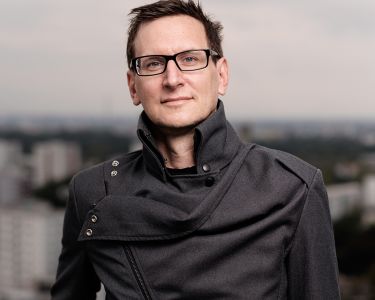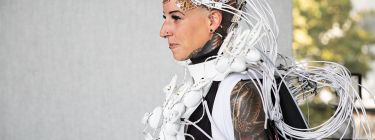
Innovation Through Universitas
Vice Rectorate for Innovation & Researchers at Johannes Kepler Universität, Linz
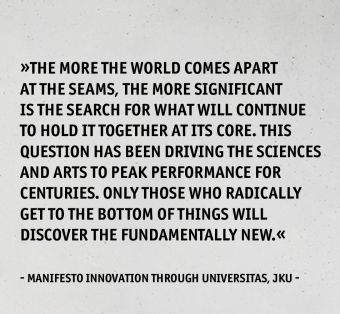
Innovation Through Universitas
The complexity and urgency of current conflict areas poses major challenges for us as a society. Digital and environmental changes are confronting us with a range of unknowns, fundamentally re-sorting our world, and doing so at an enormous speed. Automation and artificial intelligence are permeating the entire economic system, raising fundamental questions, fundamentally changing our everyday lives, and redefining human work. The consequences of global warming, from hurricanes and floods to glacier melt, are pervasive, devastating, and express the need for rapid action. The European Commission’s current work program (2021) not only puts „twin green and digital transitions“ at the top of the political agenda, but also emphasises the close intertwining of green and digital transformation. In this context, it is more important than ever to focus on their interdependencies. The Covid-19 pandemic recently showed how interdependent and interrelated everything is and how highly interconnected our world is. In a short period of time, the virus held the entire world in thrall, had an impact on all areas of our society and required cooperation across borders, institutions and disciplines.
The complexity of these challenges and the multidimensionality of networked systems require the dovetailing of different working methods, perspectives and approaches from science, business, politics, society and art. Only by entering into these synergies beyond one’s own institution, with other scientific disciplines and the integration of different actors, can novel and sustainable solutions be found. This results in a systemic change on all levels of our society. The relevance, potentials and possible practices will be elaborated in this paper using the example of higher education and the re-interweaving of art and science.
While art and science were once closely interwoven and mutually stimulating sources for the creation of something entirely new, with the end of the Renaissance they were steered in separate directions. In order to cope with the ever-increasing wealth of knowledge, the disciplines became detached from one another, leading to a high degree of specialisation and the fragmentation of knowledge.
This liaison between art and science needs to be re-established and strengthened in light of the need for innovative solutions and pressing societal and social issues. The pursuit of new knowledge and the search for solutions in the unknown have always been the driver and motor of both science and the arts.
„The analogical spirit is not only a matter of art, but also of science. May the criteria be different, artistic and scientific creativity have this in common, that it is about discovering, uncovering, endowing, or visualizing connections.“ (Gabriel 2017, p. 194)
Creative thinking, which in science as in art has led to new insights and discoveries is, as Gottfried Gabriel states, a unifying element. This makes it possible to recognise connections and to combine the familiar in new ways. As some well-known examples from the history of science show, it was often a creative idea that led to the formation of a new hypothesis, the subsequent verification of which brought the long-awaited solution to a problem. Expertise and methods for testing the hypothesis are essential. However, discovering, inventing and finding something truly new also requires creativity, which makes it possible to lead in a detached way beyond the limits of the possible.
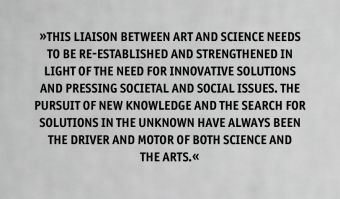
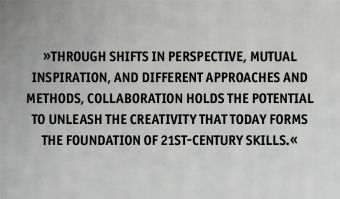
Alexander von Humboldt’s educational ideal and ideas about the university („universitas litterarum“ = „community of the sciences“) are based on holistic education in the arts and sciences and are becoming increasingly important due to current developments. Through their inherent creativity, imagination as well as execution and testing of new ideas, art and science are connected more than is generally assumed. Both are accustomed to navigating through uncharted terrain, do not shy away from complex problems, and, by exploring and creating the radically new, are the source and impetus of innovation in our society. Through shifts in perspective, mutual inspiration, and different approaches and methods, collaboration holds the potential to unleash the creativity that today forms the foundation of 21st-century skills. It is essential to focus not only on interdisciplinarity but above all on transdisciplinarity in education and research so that we do not run the risk of losing sight of the interrelationships in view of the high degree of specialisation on the one hand, and on the other hand so that new ideas can be brought into the world through mutual inspiration.
“By seeing the big picture—the interrelationships of knowledge that liberal arts offer—workers of the future can be fluid enough to adapt to changes beyond their individual control.” (Needle et al. 2007, S. 114)
This change is also clearly manifested in the change in the types of tasks occurring in the workplace. Since the 1970s, a steady increase in „non-routine analytical tasks“ and „non-routine interpersonal tasks“ can be recorded, as stated in the current OECD report. In light of the digital revolution, which is drawing a new profile of activities, „education systems must also undergo transformative change.“ (OECD 2020) The study „The Future of Employment: How susceptible are jobs to computerisation?“ by Frey and Osborn of Oxford University also caused a stir, predicting that some 47 percent of U.S. workers will be at risk. (Frey and Osborne 2013) In the study „Solving future skills Challenges“ (Universities UK 2018), the World Economic Forum and the OECD are united by the prediction that digital transformation will have a significant impact on many areas of our lives. In order to respond to these new conditions and remain capable of acting, there is a consensus that new skills will be needed, the teaching of which has been pushed too little or hardly at all to date.
“At the same time, technological change and shifts in job roles and occupational structures are transforming the demand for skills at a faster pace than ever before. Therefore, imperative for achieving such a positive vision of the future of jobs will be an economic and societal move by governments, businesses and individuals towards agile lifelong learning, as well as inclusive strategies and programmes for skills retraining and upgrading across the entire occupational spectrum. Technology-related and non-cognitive soft skills are becoming increasingly more important in tandem, and there are significant opportunities for innovative and creative multistakeholder partnerships of governments, industry employers, education providers and others to experiment and invest in new types of education and training provision that will be most useful to individuals in this new labour market context.” (World Economic Forum 2018, S. 22)
In order to prepare young people for the future world of work—the characteristics of which we can only guess at today—educational institutions have a central role and responsibility. New competencies will become necessary and require a rethinking of our knowledge transfer, learning and training opportunities and research. The rapid development of alternative models and approaches is therefore urgently needed. In addition to the acquisition of sound technical as well as broad contextual knowledge, the training of creative, social and communicative skills is central. The competence to apply this knowledge in different situations is the key to solve complex problems. Only through the power of creativity, „out of the box“ thinking, practical work and an interdisciplinary approach can entirely new ideas and approaches to solving complex problems be developed.
In the TRANSFORM project, this objective finds its first prototypical approaches. In a cooperative effort between Johannes Kepler University, the University of Applied Arts Vienna, Danube University Krems and Ars Electronica, new approaches to research and university teaching are being explored and tested. The development of future-oriented, transdisciplinary and inter-university teaching forms and formats is at the centre of the project.
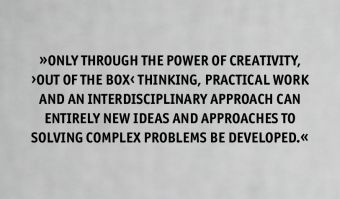
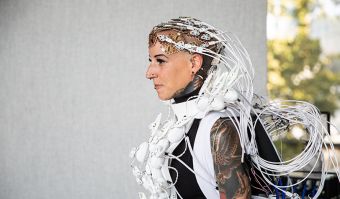
The Pangolin Scales shows how new, groundbreaking inventions can be created through the collaboration of art and science. The work was realised as part of the LIT Special Call Ars Electronica of the Johannes Kepler University Linz in 2020. The call promotes the shaping of innovative ideas through the collaboration of science and art. The Pangolin Scales features an extraordinary scale dress that moves and interacts with its environment, controlled solely by the wearer’s power of thought. This is made technically possible by a world-first, 1,024-channel brain-computer interface (BCI) that is capable of extracting information from the human brain with unprecedented resolution. It was developed by researchers at JKU’s Institute of Integrated Circuits and brain-computer interface experts at g.tec medical engineering GmbH. The impetus and inspiration for the project was provided by fashion tech designer Anouk Wipprecht, who also participated in the development. The LIT Special Call Ars Electronica Festival has been held annually since 2020.
Photo: The Pangolin Scales / Thomas Faseth (AT), Harald Pretl (AT), Christoph Guger (AT), Anouk Wipprecht (NL)
This project is part of LIT-Projects, JKU Campus. The Pangolin Scales demonstrates the world’s first 1.024 channel brain-computer interface (BCI), which is able to extract information from the human brain with an unprecedented resolution to control an interactive, fashionable dress. For further information please visit: https://ars.electronica.art/keplersgardens/en/the-pangolin-scales/
Copyright Information: Tom Mesic
Harnessing the potential of art in reshaping the European economy, in line with the goals formulated in the EU Green Deal and New European Bauhaus, is the central concern of the 12 S+T+ARTS residencies planned for 2021/22. Together with external experts from science, society, politics and business, artists will be invited to act as catalysts for change and develop concepts for a sustainable future.
As a creator of new ideas, a mediator between science and society, and a facilitator of creative, social and communicative skills, art holds enormous potential for research and education. In view of current fields of action, a closing of ranks between science and art is urgently needed, and the potential that their entanglement holds must be exploited.
References
TRANSFORM – Digital and Social Transformation through New Directions in Research and University Education is a cooperative project of Johannes Kepler University Linz, University of Applied Arts Vienna, Danube University Krems and Ars Electronica, financially enabled by the Austrian Federal Ministry of Education, Science and Research.
Zur Website
Manifest Innovation durch Universitas – written by Johannes Kepler University and the University of Applied Arts
See here: www.jku.at/en/manifest
The Pangolin Scales (2020)
Information & Videos at: Ars Electronica Festival 2020; Institutswebsite
All LIT Specialcall Ars Electronica Projects 2020: https://www.jku.at/ars-electronica-2020-in-keplers-garden/
All LIT Specialcall Ars Electronica Projects 2021: https://www.jku.at/ars-electronica-2021-a-new-digital-deal/
S+T+ARTS Regional Centres | Repairing the Present (2021/22)
The Johannes Kepler University is a scientific partner in the Challenge nº2: Circular Futures.
Sources
European Commission (2021): Commission work programme 2022. Making Europe stronger together.
Online at: https://ec.europa.eu/info/sites/default/files/cwp2022_en.pdf
Frey, Carl Benedikt; Osborne, Michael (2013): The Future of Employment: How susceptible are jobs to computerisation?
In: Oxford Martin School, 01.09.2013. Online at: https://www.oxfordmartin.ox.ac.uk/publications/the-future-of-employment/, zuletzt geprüft am 04.11.2020.
Gabriel, Gottfried (2017): Kreativität und Interdisziplinarität in den Wissenschaften.
In: Hanna Kauhaus und Norbert Krause (Hg.): Fundiert forschen. Wissenschaftliche Bildung für Promovierende und Postdocs. Wiesbaden: Springer VS, S. 191–201.
Needle, Andrew; Corbo, Christopher; Wong, Denise; Greenfeder, Gary; Raths, Linda; Fulop, Zoltan (2007): Combining Art And Science In „Arts and Sciences“ Education. In: College Teaching 55 (3), S. 114–120.
OECD (Hg.) (2020): OECD Lernkompass 2030 OECD-Projekt Future of Education and Skills 2030 – Rahmenkonzept des Lernens. Unter Mitarbeit von Bertelsmann Stiftung, Deutsche Telekom Stiftung, Education Y e.V., Global Goals Curriculum e.V., Siemens Stiftung.
Universities UK (2018): Solving future skills challenges.
Online at: https://dera.ioe.ac.uk/32069/1/solving-future-skills-challenges.pdf.
World Economic Forum (2018): The Future of Jobs Report 2018.
Online at: https://www3.weforum.org/docs/WEF_Future_of_Jobs_2018.pdf.
Kerstin Pell
Kerstin Pell works at the Vice Rector for Innovation and Researchers* at JKU and coordinates projects at the interface between art and science. She is responsible for the project „TRANSFORM – Digital and Social Transformation through New Paths in Research and University Education“ in cooperation with the University of Applied Arts Vienna and the Danube University Krems. Before that she worked in the educational and cultural sector.
Picture © JKU / Florian Voggeneder

Christopher Lindinger
Christopher Lindinger has been concerned with the social impact of new technologies and the associated cultures of innovation for more than two decades. He is considered a founding member of the Ars Electronica Futurelab and was responsible for R&D activities as co-director of the lab. Since 2019, he has been Vice Rector for Innovation and Researchers* at JKU.
Picture © JKU / Florian Voggeneder
